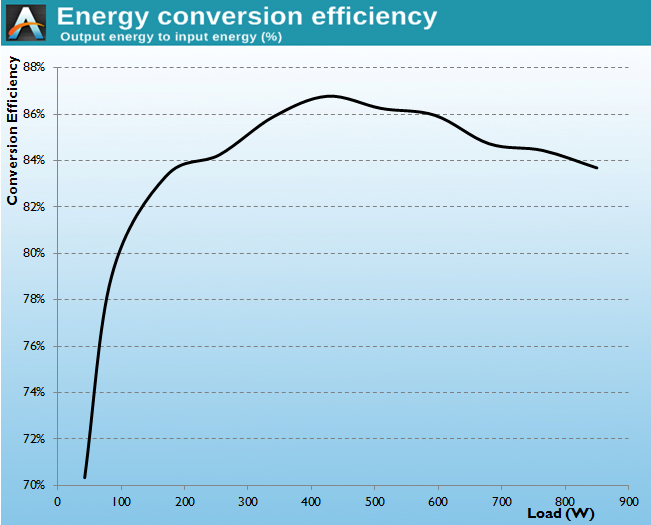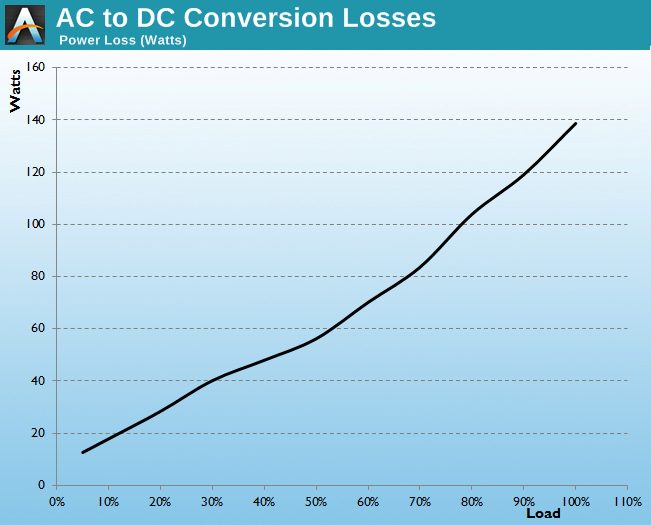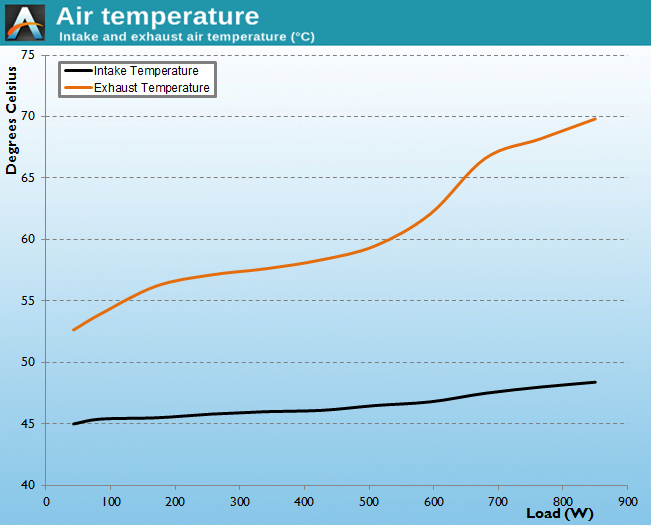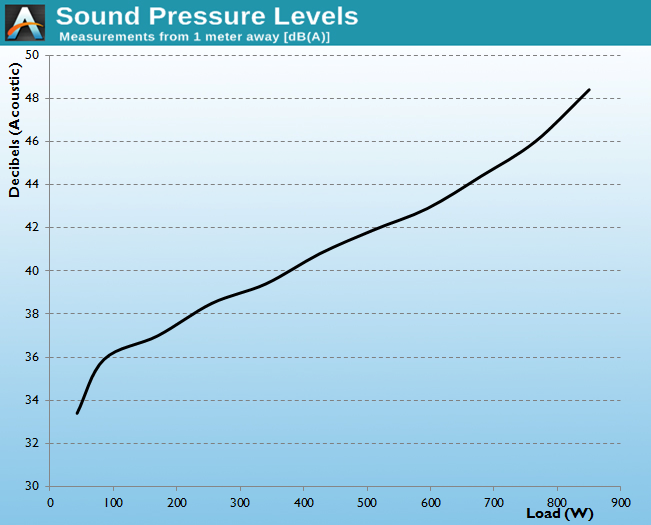be quiet! Power Zone 850W CM Power Supply Review
by E. Fylladitakis on August 14, 2014 6:00 AM EST- Posted in
- Cases/Cooling/PSUs
- PSUs
- be quiet!
- FSP
- Fortron/Source
Hot Test Results
From the tables below, you can see that the output power quality of the be quiet! Power Zone 850W CM PSU is mediocre. The maximum voltage ripple that our instrumentation recorded was 64 mV under maximum load, which is about half of the 120 mV design guide limit but not impressive for a high-performance product. With the unit heavily cross-loaded, the maximum ripple increases even further, up to 78 mV. Voltage regulation is at 2.4% on the major 12V line and a little lower on the minor 3.3V/5V lines, which is good but not unusual for a high performance power supply.
| Main Output | ||||||||
| Load (Watts) | 172.41 W | 429.67 W | 633.45 W | 842.16 W | ||||
| Load (Percent) | 20.28% | 50.55% | 74.52% | 99.08% | ||||
| Line | Amperes | Volts | Amperes | Volts | Amperes | Volts | Amperes | Volts |
| 3.3V | 4.06 | 3.39 | 10.14 | 3.39 | 15.21 | 3.36 | 20.29 | 3.33 |
| 5V | 4.06 | 5.08 | 10.14 | 5.05 | 15.21 | 5.00 | 20.29 | 4.97 |
| 12V | 11.36 | 12.15 | 28.40 | 12.11 | 42.60 | 11.89 | 56.80 | 11.86 |
| Line |
Regulation (20% to 100% load) |
Voltage Ripple (mV) | |||||
| 20% Load | 50% Load | 75% Load | 100% Load |
CL1 12V |
CL2 3.3V + 5V |
||
| 3.3V | 1.9% | 12 | 18 | 24 | 30 | 10 | 34 |
| 5V | 2.2% | 10 | 16 | 26 | 30 | 14 | 38 |
| 12V | 2.4% | 24 | 34 | 48 | 64 | 78 | 30 |
High ambient temperatures have a major impact on the energy conversion efficiency of the be quiet! Power Zone 850W CM, reducing the average nominal load (20-100%) efficiency down to 85.1 % and the maximum efficiency of the PSU to 87%. A >4% efficiency drop is very high for a premium product and is most likely caused by the high resistance of the active components (transistors) that this unit uses. The high resistance increases their thermal losses and temperature, the higher temperature increases their resistance even further, and the effect starts to cascade. Nevertheless, even though the efficiency drops quite a bit, the Power Zone 850W CM still meets the 80 Plus Bronze certification while running in a 50C environment (which isn't actually part of the 80 Plus requirements).
The cooling system of the Power Zone 850W CM displays similar cooling behavior as before once placed inside our hot box. The magnitude of the numbers changes, as the unit is obviously hotter and thus runs louder. The temperature of the unit reaches uncomfortable levels when it operates under maximum load for extended periods under such conditions, but the Power Zone 850W CM did work like a charm and we didn't encounter any issues...except for the noise levels.
As you would expect, what was already a somewhat noisy PSU becomes even more so in our hot box. The Power Zone 850W CM will be audible at virtually any load inside a hot environment, which is not exactly what be quiet!'s company scope describes. Again, we've seen better results from the competition, and what's more they have products that cost less than the Power Zone 850W.















20 Comments
View All Comments
inighthawki - Thursday, August 14, 2014 - link
Sorry, that should read:"whether or not to get a second *GPU*"
Daniel Egger - Thursday, August 14, 2014 - link
> 2) PSUs generally get their best efficiency while running at 50-60% load. So having a 750W PSU to power a 400W system provides the best efficiency. (Granted I realize for many this is a silly point, since the extra cost of the PSU itself generally will outweigh any cost savings, but maybe they like to be green, or just have the money)Your reasoning is flawed because a typical (even gamers) PC spends considerable amounts of time *way* below the maximum power rating where you'll immediately loose any advantage you would gain from having the maximum rating at the maximum efficiency point big time, especially if your system idles a lot and drops below the miraculous 20% mark.
But with a 400W system a few percent efficiency more or less really don't matter any more as there's definitely no greenness to be had anymore...
DanNeely - Thursday, August 14, 2014 - link
As a distributed computing (Boinc, primarily Einstein at home) participant, I suspect my system probably spends <95% of its operating time at full load; and my average load while gaming is probably below the non gaming average because the threshold where I have to GPU compute while playing to keep good FPS is lower than what's needed to heavily load the GPU. (Games and Compute are a lot worse at sharing GPU resources than their CPU equivalents.)inighthawki - Thursday, August 14, 2014 - link
Fair point.Flunk - Thursday, August 14, 2014 - link
It looks like they spent a good potion of the budget on appearance. Middling electronics and a loud fan don't impress me for the price. Some low end units are built better than this and I personally don't care what power supplies look like, in most cases you don't even see it.Essence_of_War - Thursday, August 14, 2014 - link
Sidenote on be Quiet's fans, is there some specific reason that they seem to use non-standard fan sizes? This unit uses a 135mm fan, and their HSFs are made for 130/135mm fans as well.DanNeely - Thursday, August 14, 2014 - link
For the PSU, it's the biggest size that will fit. Meaning that all else equal, it gives the most air movement for the least noise. On the heat sinks I'm not sure why they wouldn't just edge up to 140mm unless it's to exploit volume discounts from their supplier by using the same fans for both products.piroroadkill - Thursday, August 14, 2014 - link
I thought the 135mm fan in PSU thing was because Zalman has a patent on 140mm fans in power supplies.piroroadkill - Thursday, August 14, 2014 - link
Actually, I'm going to correct myself, because I don't think it's Zalman. I posted the same thing in 2011, and someone said it was HEC that has the patent.DanNeely - Thursday, August 14, 2014 - link
*BOGGLE*That's even more appalling than the "standard PC architecture feature on a smartphone" patents because I can't imagine any way that "use the biggest fan that will fit" could be obfuscated into something that a kindergartener, never mind a patent office reviewer, couldn't realize was trivial.